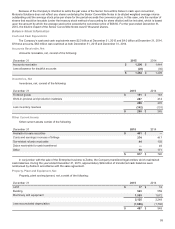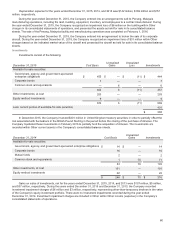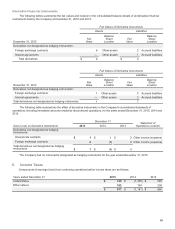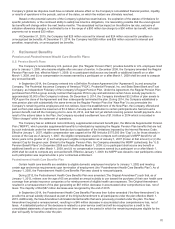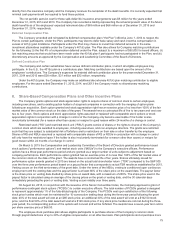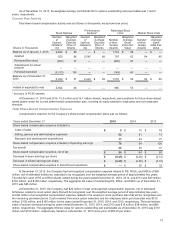Motorola 2015 Annual Report Download - page 69
Download and view the complete annual report
Please find page 69 of the 2015 Motorola annual report below. You can navigate through the pages in the report by either clicking on the pages listed below, or by using the keyword search tool below to find specific information within the annual report.
68
Differences between income tax expense (benefit) computed at the U.S. federal statutory tax rate of 35% and income tax
expense (benefit) as reflected in the consolidated statements of operations are as follows:
Years ended December 31 2015 2014 2013
Income tax expense (benefit) at statutory rate $ 321 35.0 % $ (406) 35.0 % $ 308 35.0 %
Tax on non-U.S. earnings (46) (5.0)% (27) 2.3 % 17 1.9 %
State income taxes, net of federal benefit 24 2.6 % (30) 2.6 % 8 0.9 %
Recognition of previously unrecognized income tax
benefits 10.1% (29) 2.5 % 6 0.7 %
Other provisions 14 1.6 % 9 (0.7)% (4) (0.5)%
Valuation allowances (9) (1.0)% 55 (4.7)% (3) (0.3)%
Section 199 deduction (19) (2.1)% (12) 1.0 % (14) (1.6)%
Tax on undistributed non-U.S. earnings (7) (0.8)% (19) 1.6 % (22) (2.5)%
Research credits (5) (0.5)% (6) 0.5 % (18) (2.0)%
Tax benefit of repatriated non-U.S. earnings ——% — — % (337) (38.3)%
$ 274 29.9 % $ (465) 40.1 % $ (59) (6.7)%
Gross deferred tax assets were $3.5 billion and $3.6 billion at December 31, 2015 and 2014, respectively. Deferred tax
assets, net of valuation allowances, were $3.4 billion at both December 31, 2015 and 2014, respectively. Gross deferred tax
liabilities were $1.2 billion and $774 million at December 31, 2015 and 2014, respectively.
Significant components of deferred tax assets (liabilities) are as follows:
December 31 2015 2014
Inventory $30$34
Accrued liabilities and allowances 136 148
Employee benefits 612 799
Capitalized items 357 379
Tax basis differences on investments 14 (10)
Depreciation tax basis differences on fixed assets 19 52
Undistributed non-U.S. earnings (19) (18)
Tax carryforwards 1,028 1,246
Business reorganization 20 22
Warranty and customer liabilities 20 19
Deferred revenue and costs 146 136
Valuation allowances (129) (226)
Deferred charges 41 39
Other 3(38)
$2,278$ 2,582
At December 31, 2015 and 2014, the Company had valuation allowances of $129 million and $226 million, respectively,
against its deferred tax assets, including $98 million and $195 million, respectively, relating to deferred tax assets for non-U.S.
subsidiaries. The Company’s valuation allowances for its non-U.S. subsidiaries had a net decrease of $97 million during 2015
and a net increase of $17 million during 2014. The decrease in the valuation allowance relating to deferred tax assets of non-
U.S. subsidiaries during 2015 relates to the expiration of net operating losses, the release of a Singapore valuation allowance,
and the change in the value of net deferreds related to pension in the United Kingdom. The increase in the valuation allowance
relating to deferred tax assets of non-U.S. subsidiaries during 2014 related to deferred tax assets considered to be not more-
likely-than-not to be realizable based on estimates of future taxable income.
The Company’s U.S. valuation allowance did not change during 2015 compared to a net increase of $9 million during
2014. The U.S. valuation allowance of $31 million as of December 31, 2015 primarily relates to state tax carryforwards. The
Company believes that the remaining deferred tax assets are more-likely-than-not to be realizable based on estimates of future
taxable income and the implementation of tax planning strategies.



